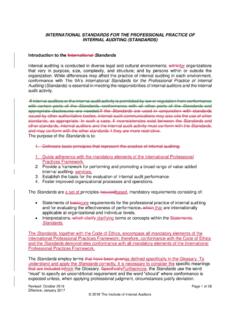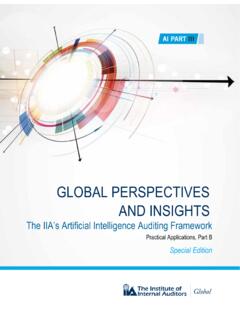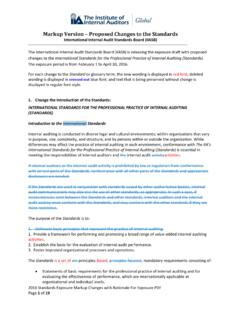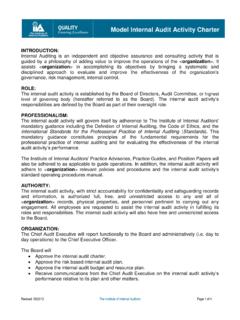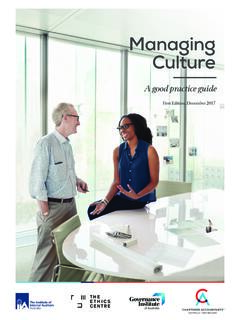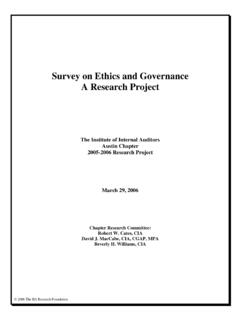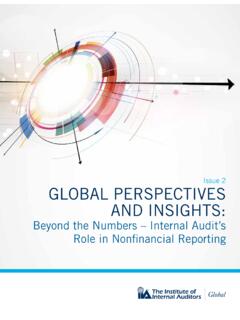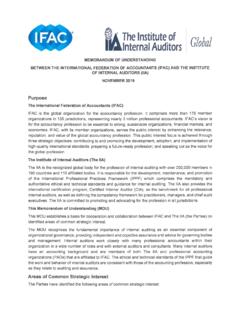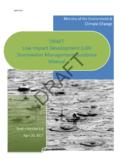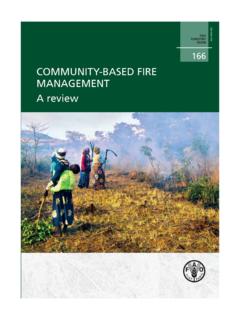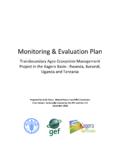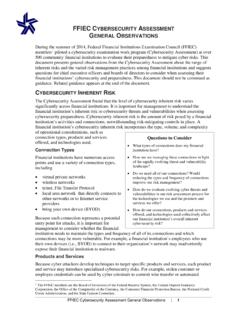Transcription of Discussion paper Strategy-related auditing
1 Discussion paperStrategy- related auditingExploratory research on the consideration of strategic risk and organizational strategy in internal audits June 2015In collaboration withNetherlands2 Contents ForewordExecutive summary1. Introduction and context The evolving role of internal audit About this Discussion paper2. strategy and Strategy-related audits Organizational strategy - a diffuse landscape Two categories of Strategy-related audits3. Strategic risk audits Strategic risk audits4. strategy process audits strategy process audits Pro s and con s of strategy process audits Techniques and competences Factors for success and failure5. Conclusion Research conclusions Future research opportunities and next stepsAppendices I Strategy-related audit appearances II Example of reference model III The research project IV References V Glossary3 Dear reader, This publication Strategy-related auditing is the result of a joint effort between KPMG Internal audit, Risk & Compliance services and IIA the purpose of this research was to explore how company strategies and strategic risks play a part in the internal audit approaches adopted by Dutch corporations.
2 The research identified no less than nine different archetypes of Strategy-related auditing . The applicabi-lity of any of them depends on the culture and the maturity levels of both organizations and internal audit functions. As with many aspects of internal auditing , the option chosen needs to be fit-for-purpose. This paper is intended to open the Discussion between Chief Audit Executives and their key stakeholders ( , the Boards) on incorporating the company s strategy in internal audit activities. It is also a call to action for those in our profession dealing with professional practices to consider developing additional guidance on this topic for behalf of IIA the Netherlands I wish to acknowledge the leadership provided by KPMG personnel on this project. KPMG will present the conclusions at the occasion of the 2015 Conference of IIA the hope the document will provide you with lots of food for thought. Vincent Moolenaar,President IIA the Netherlands Dear reader, We are delighted that we have had the opportunity to work together with the IIA The Netherlands on this publication Strategy-related auditing .
3 In today s dynamic business environment organizations face fun-damental changes and increased risks and therefore the need for more independent assurance has never been greater, also on strategy related Board members (both executives and non-executives) we more often experience a deeper needto understand whether organizations have made the right strategic choices and have subsequently imple-mented the formulated strategy accordingly. A main point of attention is the degree to which top manage-ment is aware of the risks that relate to the chosen strategy . The internal audit function can playan impor-tant role in providing these independent insights, but we experience that this is highly dependent on the (perceived) quality of the internal audit hope that this publication will result in an open Discussion between Chief Audit Executives and their Boards, so that the added value delivered by the internal audit function can continue to increase. As chair-man of the Audit Committee Institute please consider this as an open invitation to have this Discussion together with the members of our van der Heijden,Partner KPMG and Chairman of Audit Committee Institute Foreword4 The word strategy can nowadays be found in almost every internal audit activity plan.
4 But what does it actually mean? There are many different manners in which organizations and internal audit functions deal with organizational strategy . This Discussion paper Strategy-related auditing explores the role of Internal Audit Functions (IAFs) in the strategic management process of an organization. It is based on documenta-tion and desk research, a questionnaire-based survey amongst Chief Audit Executives (CAEs), personal interviews with CAEs and board members (both executive and non-executive), and several round table discussions with CAEs (in charge of both large and small IAFs). The objective of this research was to assess the degree to which IAFs are currently considering organiza- tional strategy and the organization s strategic management process in their audit assignments and annual audit plans. Based on this Discussion paper we encourage the profession to further explore the topic and for the Institute of Internal Auditors to provide more exploratory research reveals that there is a wide variety in how IAFs deal with strategic risks and organi-zational strategy .
5 We found nine appearances of Strategy-related auditing during our research. These can be divided into two distinct categories: strategic risk audits and strategy process audits. Strategic risk audits focus on risks that are the result of pursuing certain strategically important organizational goals. Strategyprocess audits, on the other hand, assess formulation, implementation, evaluation and control of the strategic management process or (the content of) the formulated strategy itself. Four out of nine identified appearances we categorize as strategic risk audits, five we categorize as strategy process risk audits in their lightest form are a logical consequence of the widely adopted risk-based audit-ing approach. Good practices we encountered include explicitly and consistently linking findings back to the organizational strategy and taking a broader (multiple angle) approach where for every audit alignment with COSO ERM components (strategic, operational, financial and compliance) are considered.
6 1 Executive summary1 Risk-based auditing2 Strategic risk project auditing8 strategy process program auditing5 strategy formulation process auditing3 Decentralized strategic alignment9 strategy evaluation and control auditing6 auditing of decentra-lized strategies7 strategy implemen-tation auditing4 COSO ERM approachStrategy- related auditingStrategy risk auditsStrategy process audits5In terms of strategic relevance the organizational strategy itself and the process the organization is following is paramount, followed by the strategic topics, themes, decisions and areas that are derived from the or-ganizational strategy . As such, performing strategic risk audits could be seen as a first step towards strategy process audits. In order to add the most value when performing strategy process audits, respondents indicated that it requires more extensive strategy and strategy implementation knowledge. Therefore strategy process audits might require the inclusion of a strategy subject matter expert in the audit team.
7 But also when perform-ing a strategic risk audit subject matter experts can add additional value to the audits, although this type of audit is often conducted without the involvement of strategy subject matter it comes to the strategy management process, many CAEs have reservations about auditing the strategy formulation phase or assessing the content of the strategy . The majority of CAEs say that strategy process audits should focus on the implementation phase, which deals with translating the strategy into ob-jectives and performance measures, and implementing these into operational plans. Regarding the strategy evaluation phase, there appears to be less demand for a role for the IAF. Most CAEs state that a strategy process audit should be focused on the process of the strategy formulation rather than on its content. However, nearly half of CAEs say that a strategy process audit can apply to both process and members are more hesitant than CAEs in general about auditing each of the phases of the strategy process.
8 Some of them say that there is no role for the IAF in the strategy formulation process. Concerns are less for an audit on the following two phases of the strategy process, the strategy execution and evalua-tion. Several conditions should be met to make Strategy-related audits successful. An important success factor is the relationship with management; there must be a certain level of mutual trust. Seniority of the individual auditors while performing strategy process audits is an asset mentioned several times during the research reveals that most IAFs focus on strategic risks in their audits and audit plans. Some of the four distinct types of strategic risk audits are common practice for many IAFs. Still more impact can be made by making the link between findings and strategy more explicit. This would close the loop of strategy , strategic risks, audit subjects, observations and findings linked back to strategy again (Demming-cycle Plan-Do-Check-Act). A broad approach to audit subjects as encountered at one IAF (referred to as the COSO ERM approach) can be regarded as one example of a good practice.
9 Further, the results of our study show that IAFs are increasingly involved in auditing the strategic management process. The IAF s involve-ment and added value are mostly acknowledged when providing information to stakeholders about the quality of strategy implementation through audits. In addition, CAEs are often acknowledged as a valuable sparring partner for management due to their knowledge of the internal organization and its eight most important takeaway s of our research are:1. Every organization has its own approach towards defining and implementing strategy . Differen- ces relate to: the level of detail, the frequency and degree of formalization of the strategy , connectivity with budgets, involvement of internal and external parties, use of programs or projects for strategy implementation, the extent to which the strategy is evaluated, etc. 2. IAFs deal very differently with strategic risks and organizational strategy as well. Most internal audit activity plans include strategy , however what is actually done varies widely between IAFs;3.
10 A distinction can be made between audit types that focus on strategic risks and audit types aimed at the strategy process and the organizational strategy itself. Nine forms of Strategy-related auditing were identified during our research, which we divided over two categories; strategic risk audits and strategy process audits;4. In general Board Members are more reluctant when it comes to strategy process auditing than CAEs are. Both Board Members and CAEs see added value in auditing strategy implementation and execution, however they have reservations when it comes to auditing the strategy formula- tion. The reservations mentioned are both principle and practical in nature; 5. Most organizations and their IAFs focus on strategy formulation and execution, whereas few seem to engage in formal strategy evaluation;6. The relationship between the CAE and the Board and the perception that the Board has of internal audit is a decisive element in whether the IAF will be asked to perform Strategy-related audits;7.
